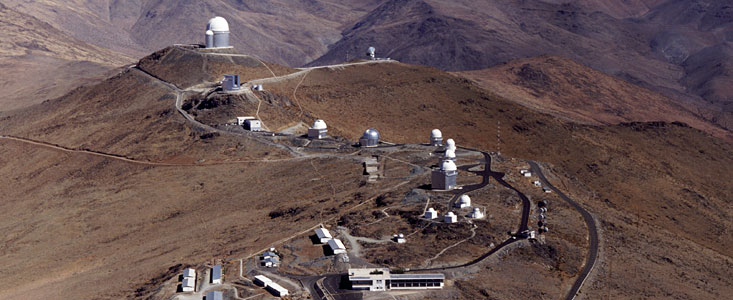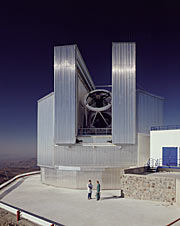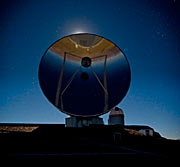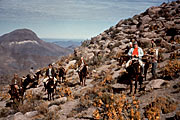Nota de Imprensa
ESO’s First Observatory Celebrates 40th Anniversary
24 de Março de 2009
ESO’s La Silla Observatory, which is celebrating its 40th anniversary, became the largest astronomical observatory of its time. It led Europe to the frontline of astronomical research, and is still one of the most scientifically productive in ground-based astronomy.
With about 300 refereed publications attributable to the work of the observatory per year, La Silla remains at the forefront of astronomy. It has led to an enormous number of scientific discoveries, including several “firsts”. The HARPS spectrograph is the world’s foremost exoplanet hunter. It detected the system around Gliese 581, which contains what may be the first known rocky planet in a habitable zone, outside the Solar System (eso0722). Several telescopes at La Silla played a crucial role in discovering that the expansion of the Universe is accelerating and in linking gamma-ray bursts — the most energetic explosions in the Universe since the Big Bang – with the explosions of massive stars. Since 1987, the ESO La Silla Observatory has also played an important role in the study and follow-up of the nearest supernova, SN 1987A (eso0708).
“The La Silla Observatory continues to offer the astronomical community exceptional capabilities,” says ESO Director General, Tim de Zeeuw. “It was ESO’s first presence in Chile and as such, it triggered a very long and fruitful collaboration with this country and its scientific community.”
The La Silla Observatory is located at the edge of the Chilean Atacama Desert, one of the driest and loneliest areas of the world. Like other observatories in this geographical area, La Silla is located far from sources of polluting light and, as the Paranal Observatory that houses the Very Large Telescope, it has one of the darkest and clearest night skies on the Earth.
At its peak, La Silla was home to no fewer than 15 telescopes, among them the first — and, for a very long time, the only — telescope working in submillimetric waves (the 15-metre SEST) in the southern hemisphere, which paved the way for APEX and ALMA, and the 1-metre Schmidt telescope, which completed the first photographic mapping of the southern sky. The telescopes at La Silla have also supported countless space missions, e.g., by obtaining the last images of comet Shoemaker Levy 9 before it crashed into Jupiter, thereby helping predicting the exact moment when the Galileo spacecraft should observe to capture images of the cosmic collision.
“Many of the current generation of astronomers were trained on La Silla where they got their first experience with what were then considered large telescopes,” says Bruno Leibundgut, ESO Director for Science.
While some of the smaller telescopes have been closed over the years, frontline observations continue with the larger telescopes, aided by new and innovative astronomical instruments. La Silla currently hosts two of the most productive 4-metre class telescopes in the world, the 3.5-metre New Technology Telescope (NTT) and the 3.6-metre ESO telescope.
"The NTT broke new ground for telescope engineering and design," says Andreas Kaufer, director of the La Silla Paranal Observatory. The NTT was the first in the world to have a computer-controlled main mirror (active optics), a technology developed at ESO and now applied to the VLT and most of the world’s current large telescopes. The ESO 3.6-metre telescope, which was for many years one of the largest European telescopes in operation, is now home to the extrasolar planet hunter, HARPS (High Accuracy Radial velocity Planet Searcher), a spectrograph with unrivalled precision.
The infrastructure of La Silla is used by many of the ESO member states for targeted projects such as the Swiss 1.2-metre Euler telescope, the Italian Rapid-Eye Mount (REM) and French TAROT gamma-ray burst chasers as well as more common user facilities such as the 2.2-metre telescope of the German Max Planck Society and the 1.5-metre Danish telescopes. The 67-million pixel Wide Field Imager on the 2.2-metre telescope has taken many amazing images of celestial objects, some of which have now become icons of their own.
The La Silla Observatory, north of the town of La Serena, has been a stronghold of the organisation’s capabilities since the 1960s. The site was chosen after an initial prospecting expedition — partly on horseback — to the Chilean Andes, during 1963 and 1964, by the first ESO Director General, Otto Heckmann, and several senior astronomers. This was done with the help of AURA, which had just chosen to install an observatory at nearby Cerro Tololo. In the following years, the site was developed and the first small and mid-sized telescopes were erected, followed by the 3.6-metre telescope in 1977 and the NTT in 1989. On 25 March 1969, an audience of more than 300 people, including the then Chilean President, Eduardo Frei and the Minister of Education of Sweden, Olof Palme, celebrated the completion of the first phase of the construction programme.
“The erection of the La Silla Observatory is not only of vast importance for the future of astronomical research, but also a striking example of what may be achieved through efficient, and truly far-reaching, international cooperation,” said Olof Palme at the time.
The future of the La Silla Observatory remains bright. In 2007 ESO’s Council endorsed a plan that maintains an important role for La Silla, alongside the other large ESO facilities, the VLT, ALMA and the E-ELT.
La Silla also plans to host new national telescope projects and visitor instruments — an option that has already received a strong positive response from the astronomical community.
Informações adicionais
- More about La Silla
- Images of La Silla
- ESO Timeline
Contactos
Andreas Kaufer
ESO
Chile
Tel: +49 89 3200 5303
Email: akaufer@eso.org
Henri Boffin
ESO
Garching, Germany
Tel: +49 89 3200 6222
Email: hboffin@eso.org
Valentina Rodriguez
ESO
Chile
Tel: +56 2 463 3123
Email: vrodrigu@eso.org
Sobre a Nota de Imprensa
| Nº da Notícia: | eso0912 |
| Legacy ID: | PR 12/09 |
| Nome: | La Silla |
| Tipo: | Unspecified : Technology : Observatory |
| Facility: | Other |
Our use of Cookies
We use cookies that are essential for accessing our websites and using our services. We also use cookies to analyse, measure and improve our websites’ performance, to enable content sharing via social media and to display media content hosted on third-party platforms.
ESO Cookies Policy
The European Organisation for Astronomical Research in the Southern Hemisphere (ESO) is the pre-eminent intergovernmental science and technology organisation in astronomy. It carries out an ambitious programme focused on the design, construction and operation of powerful ground-based observing facilities for astronomy.
This Cookies Policy is intended to provide clarity by outlining the cookies used on the ESO public websites, their functions, the options you have for controlling them, and the ways you can contact us for additional details.
What are cookies?
Cookies are small pieces of data stored on your device by websites you visit. They serve various purposes, such as remembering login credentials and preferences and enhance your browsing experience.
Categories of cookies we use
Essential cookies (always active): These cookies are strictly necessary for the proper functioning of our website. Without these cookies, the website cannot operate correctly, and certain services, such as logging in or accessing secure areas, may not be available; because they are essential for the website’s operation, they cannot be disabled.
Functional Cookies: These cookies enhance your browsing experience by enabling additional features and personalization, such as remembering your preferences and settings. While not strictly necessary for the website to function, they improve usability and convenience; these cookies are only placed if you provide your consent.
Analytics cookies: These cookies collect information about how visitors interact with our website, such as which pages are visited most often and how users navigate the site. This data helps us improve website performance, optimize content, and enhance the user experience; these cookies are only placed if you provide your consent. We use the following analytics cookies.
Matomo Cookies:
This website uses Matomo (formerly Piwik), an open source software which enables the statistical analysis of website visits. Matomo uses cookies (text files) which are saved on your computer and which allow us to analyze how you use our website. The website user information generated by the cookies will only be saved on the servers of our IT Department. We use this information to analyze www.eso.org visits and to prepare reports on website activities. These data will not be disclosed to third parties.
On behalf of ESO, Matomo will use this information for the purpose of evaluating your use of the website, compiling reports on website activity and providing other services relating to website activity and internet usage.
Matomo cookies settings:
Additional Third-party cookies on ESO websites: some of our pages display content from external providers, e.g. YouTube.
Such third-party services are outside of ESO control and may, at any time, change their terms of service, use of cookies, etc.
YouTube: Some videos on the ESO website are embedded from ESO’s official YouTube channel. We have enabled YouTube’s privacy-enhanced mode, meaning that no cookies are set unless the user actively clicks on the video to play it. Additionally, in this mode, YouTube does not store any personally identifiable cookie data for embedded video playbacks. For more details, please refer to YouTube’s embedding videos information page.
Cookies can also be classified based on the following elements.
Regarding the domain, there are:
- First-party cookies, set by the website you are currently visiting. They are stored by the same domain that you are browsing and are used to enhance your experience on that site;
- Third-party cookies, set by a domain other than the one you are currently visiting.
As for their duration, cookies can be:
- Browser-session cookies, which are deleted when the user closes the browser;
- Stored cookies, which stay on the user's device for a predetermined period of time.
How to manage cookies
Cookie settings: You can modify your cookie choices for the ESO webpages at any time by clicking on the link Cookie settings at the bottom of any page.
In your browser: If you wish to delete cookies or instruct your browser to delete or block cookies by default, please visit the help pages of your browser:
Please be aware that if you delete or decline cookies, certain functionalities of our website may be not be available and your browsing experience may be affected.
You can set most browsers to prevent any cookies being placed on your device, but you may then have to manually adjust some preferences every time you visit a site/page. And some services and functionalities may not work properly at all (e.g. profile logging-in, shop check out).
Updates to the ESO Cookies Policy
The ESO Cookies Policy may be subject to future updates, which will be made available on this page.
Additional information
For any queries related to cookies, please contact: pdprATesoDOTorg.
As ESO public webpages are managed by our Department of Communication, your questions will be dealt with the support of the said Department.





